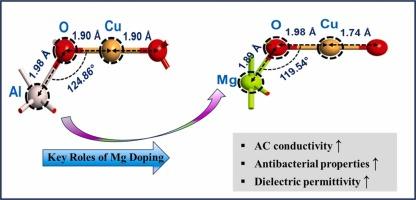Mg掺杂对CuAlO2球花纳米结构光学、介电和抗菌性能的影响:模型和实验结果
IF 6.3
2区 材料科学
Q2 CHEMISTRY, PHYSICAL
引用次数: 0
摘要
采用自燃烧法成功合成了CuAl1−xMgxO2 (x = 0.0, 0.05)的Mg掺杂CuAlO2纳米粒子。采用XRD和FESEM技术对其微观结构进行表征。这样的表征证实了CuAlO2 NPs与Mg的成功掺杂,没有出现任何寄生峰,从而保持了它们的单相。将Hall-Williamson关系应用于XRD结果有利于样品粒径的提取,发现Mg掺杂后样品粒径增大。随着Mg掺杂剂的引入,通过吸光度光谱的红移观察到光学带隙的衰减。通过温度相关LCR光谱观察到,掺杂也产生了介电常数和电导率的增强。应用Mg - cualo2分别对革兰氏阴性菌大肠杆菌(E. coli)和革兰氏阳性菌牛链球菌(S. bovis)进行了膜片扩散试验。本研究研究了“Mg掺杂对CuAlO2球花纳米结构的光学、介电和抗菌性能的影响”。合成的纯的和掺镁的CuAlO2纳米粒子在理论研究和CuAlO2衍生的生物医学应用方面都有很大的前景。介质特性,如介电常数,损耗正切,和交流电导率,发现增加了镁的掺杂。此外,mg掺杂的CuAlO2纳米颗粒表现出比纯CuAlO2更强的抗菌活性。Mg的加入引起了吸收峰的红移,表明带隙能量从3.02 eV降低到2.98 eV。本文还利用基于DFT的第一性原理计算方法,计算和分析了镁掺杂对CuAlO2晶体能带结构的调制作用。对于DFT分析,作者利用HSE06混合泛函配对双-ζ极化基集进行精确的能量计算。本文还利用第一性原理计算方法对CuAlO2晶体中Mg掺杂引起的能带结构调制进行了计算和分析。本文章由计算机程序翻译,如有差异,请以英文原文为准。

Impact of Mg doping on optical, dielectric and antibacterial properties with invitro analysis of CuAlO2 spherical-flower nanostructures: modeling and experimental results
Nanoparticles (NPs) of Mg doped CuAlO2 of the composition CuAl1−xMgxO2 (x = 0.0, 0.05) have been successfully synthesized through auto combustion method. XRD and FESEM techniques were applied for the characterization of their microstructures. Such characterization confirmed the successful doping of CuAlO2 NPs with Mg without any appearance of parasitic peaks, thus maintaining their single phase as well. The application of the Hall-Williamson relation to XRD results facilitated the extraction of sample particle size, which was found to increase after the introduction of the Mg dopant. With the introduction of Mg dopant, a decrement in the optical band gap was observed through a red shift in the absorbance spectrum. Doping also generated enhancement of the dielectric permittivity as well as conductivity, as observed through the temperature-dependent LCR spectroscopy. An application of Mg doped-CuAlO2 was proved as an anti-bacterial agent disk diffusion assay method against Escherichia coli (E. coli.) as Gram Negative and Streptococcus bovis (S. bovis) as Gram Positive bacteria, respectively. This study investigates the “Impact of Mg doping on optical, dielectric and antibacterial properties for CuAlO2 spherical-flower nanostructures”. The synthesized pure and Mg-doped CuAlO2 nanoparticles present a substantial prospect for both theoretical research and the development of CuAlO2-derived biomedical applications. The dielectric characteristics, such as permittivity, loss tangent, and AC conductivity, were found to increase with Mg doping. Additionally, Mg-doped CuAlO₂ nanoparticles exhibited more potent antibacterial activity than pure CuAlO2. The incorporation of Mg induced a red shift in the absorption peak, signifying a decrease in the band gap energy from 3.02 eV to 2.98 eV. The modulation in the energy band structure due to Mg doping in CuAlO2 crystal have also been calculated and analyzed in the work using the DFT based First Principle calculations. For DFT analysis the authors have utilized HSE06 hybrid functional paired with double-ζ polarized basis set for accurate energetic calculations. The modulation in the energy band structure due to Mg doping in CuAlO2 crystal has also been calculated and analyzed in the work using the First Principle calculations.
求助全文
通过发布文献求助,成功后即可免费获取论文全文。
去求助
来源期刊

Journal of Alloys and Compounds
工程技术-材料科学:综合
CiteScore
11.10
自引率
14.50%
发文量
5146
审稿时长
67 days
期刊介绍:
The Journal of Alloys and Compounds is intended to serve as an international medium for the publication of work on solid materials comprising compounds as well as alloys. Its great strength lies in the diversity of discipline which it encompasses, drawing together results from materials science, solid-state chemistry and physics.
 求助内容:
求助内容: 应助结果提醒方式:
应助结果提醒方式:


